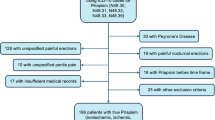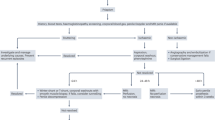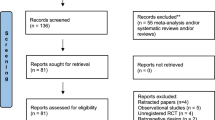Abstract
Low-molecular-weight heparin (LMWH) therapy has recently been proposed as a cause of ischemic priapism. The evidence, however, remains scarce, as there are very few published cases of LMWH-induced priapism to date. The implications of such events are significant as ischemic priapism is a medical emergency. In current clinical practice we are seeing a trend towards LMWH therapies replacing unfractionated heparin (UFH). As LMWH therapies continue to gain favor, we will potentially see more cases of LMWH-induced priapism. As such, consideration should be given to determine the underlying pathophysiology and incidence of LMWH-induced priapism. Herein, we present the case of a 33-year-old male with priapism in the setting of tinzaparin treatment.
This is a preview of subscription content, access via your institution
Access options
Subscribe to this journal
Receive 12 print issues and online access
$259.00 per year
only $21.58 per issue
Buy this article
- Purchase on SpringerLink
- Instant access to full article PDF
Prices may be subject to local taxes which are calculated during checkout
Similar content being viewed by others
References
Montague DK, Jarow J, Broderick GA, Dmochowski R, Heaton J, Lue T, et al. American Urological Association guideline on the management of priapism. J Urol. 2003;170:1318–24.
Kuefer R, Bartsch G, Herkommer K, Kramer SC, Kleinschmidt K, Volkmer BG. Changing diagnostic and therapeutic concepts in high-flow priapism. Int J Impot Res. 2005;17:109–13.
Salonia. A, Eardley I, Giuliano F, Hatzichristou D, Moncada Y, Vardi E, et al. European association of urology guidelines on priapism. Eur Urol. 2014;65:480–9.
Brichart N, Delavierre D, Peneau M, Ibrahim H, et al. Priapism associated with antipsychotic medications: a series of four patients. Prog Urol. 2008;18:669–73.
Brunett AL, Bivalacqua TJ. Priapism: current principles and practice. Urol Clin North Am. 2007;34:631–42.
Kovac JR, Mark SK, Garcia MM, Lue TF. A physiology-based approach to the management of early priapism. Asian J Androl. 2013;15:20–6.
Basset J, Rajfer J. Diagnostic and therapeutic options for the management of ischemic and non-ischemic priapism. Rev Urol. 2010;12:56–63.
Burke BJ, Scott GL, Smith PJ, Wakerley GR. Heparin associated priapism. Postgrad Med J. 1983;59:332–33.
Duggan ML, Morgan C. Heparin: a cause of priapism? South Med J. 1970;63:1131–34.
Klein LA, Hall RL, Smith RB. Surgical treatment of priapism: with a note on heparin-induced priapism. J Urol. 1972;108:104–6.
Sale D, Cameron JS. Letter: Priapism during regular dialysis. Lancet. 1974;2:1567–68.
Bschleipfer TH, Hauck EW, Diemer TH, et al. Case report: heparin induced priapism. Int J Impot Res. 2001;13:357–9.
Clark SK, Tremann JA, Sennewald FR, Donaldon JA. Priapism: an unusual complication of heparin therapy for sudden deafness. Am J Otolaryngol. 1981;2:69–72.
Adjiman S, Fava P, Bitker MO, Chatelain C. Priapisme induit par I’he´parine—un prognostic plus sombre? Ann Urol. 1988;22:125–8.
De Siati M, Chierigo P, Contin F, Lazzarotto M, Franzolin N. Priapism as a complication of heparin therapy. Arch Ital Urol Androl. 1999;71:201–2.
Routledge PA, Shetty HG, White JP, Collins P. Case studies in therapeutics: warfarin resistance and inefficacy in a man with recurrent thromboembolism, and anticoagulant-associated priapism. Br J Clin Pharmacol. 1998;46:343–6.
Lin PH, Bush RL, Lumsden AB. Low molecular weight heparin induced priapism. J Urol. 2004;172:263.
Carmoi T, Skopinski S, Constans J, Vahedy A, Conri C. Priapism and low-molecular-weight heparin. Case report. Rev Med Intern. 2001;22:1002–3.
Gong Z, Zhang Y, Chu H, Lian P, Zhang L, Sun P, et al. Priapism as the initial symptom of primary penile lymphoma: a case report. Oncol Lett. 2014;8:1929–32.
Madeb R, Rub R, Erlich N, Hegarty PK, et al. Longstanding priapism as presentation of lymphoma. Am J Hematol. 2007;82:87.
Kulmala RV, Lehtonen TA, Lindholm TS, Tammela TL. Permanent open shunt as a reason for impotence or reduced potency after surgical treatment of priapism in 26 patients. Int J Impot Res. 1995;7:175–80.
McGowan KE, Makari J, Diamantouros A, Bucci C, Rempel P, Selby R, et al. Reducing the hospital burden of heparin-induced thrombocytopenia: impact of an avoid-heparin program. Blood. 2016;127:1954–9.
Acknowledgments
No external resources/funding was provided to complete this research. This is original work with equal contributions from both authors.
Author information
Authors and Affiliations
Corresponding author
Ethics declarations
Competing interests
The authors declare that they have no competing financial interest.
Rights and permissions
About this article
Cite this article
Purnell, J., Abdulla, A.N. Case report: ischemic priapism secondary to tinzaparin. Int J Impot Res 30, 62–64 (2018). https://doi.org/10.1038/s41443-017-0008-0
Received:
Revised:
Accepted:
Published:
Issue date:
DOI: https://doi.org/10.1038/s41443-017-0008-0
This article is cited by
-
Tinzaparin sodium
Reactions Weekly (2018)



